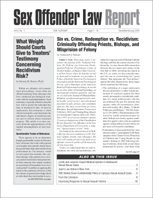Public Response to, Support for, Knowledge About, and Use of SORN Information
Author: Rachel Bandy, Ph.D..
Source: Volume 12, Number 04, June/July 2011 , pp.49-51(3)

next article > |return to table of contents
Abstract:
Sex offender registration and/or notification (SORN) laws have been in existence in the United States in various forms for over 70 years. A stated goal of contemporary SORN laws is to serve as a citizen-driven crime prevention tool—the assumption being that, if the public has knowledge of a perceived sexual threat in their community, they will undertake protective behaviors to mitigate victimization risk. The means through which the public may become informed of sex offenders have grown exponentially over the past 15 years due to both gains in technology and ever-expansive laws granting unprecedented access to criminal information. Want to know if a registered sex offender resides in your neighborhood? There is an app for that. Despite a growing body of literature on the effect of SORN laws on offenders, there is limited empirical research on the effect of these laws on the public; specifically, the extent and accuracy of public knowledge surrounding the registries, the manner in which members of the public access registry information, and how people respond to or act upon that information. Presented here is a brief synopsis of the research findings to-date on these topics.Keywords: Sex Offender Registration and Notification Laws; Protective Behavior Adoption; Perceived Risk
Affiliations:
1: Simpson College.